Page 1572 of 2896
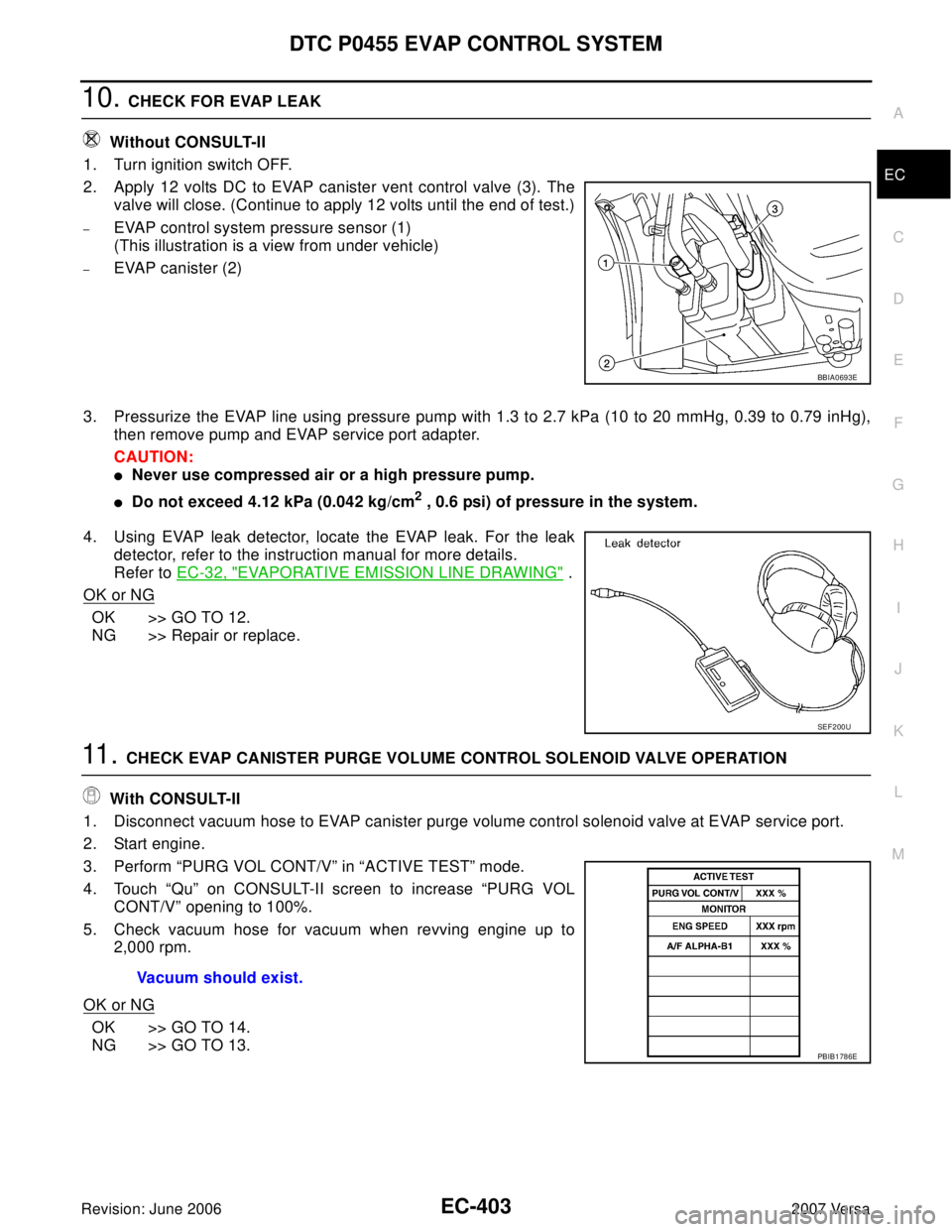
DTC P0455 EVAP CONTROL SYSTEM
EC-403
C
D
E
F
G
H
I
J
K
L
MA
EC
Revision: June 20062007 Versa
10. CHECK FOR EVAP LEAK
Without CONSULT-II
1. Turn ignition switch OFF.
2. Apply 12 volts DC to EVAP canister vent control valve (3). The
valve will close. (Continue to apply 12 volts until the end of test.)
–EVAP control system pressure sensor (1)
(This illustration is a view from under vehicle)
–EVAP canister (2)
3. Pressurize the EVAP line using pressure pump with 1.3 to 2.7 kPa (10 to 20 mmHg, 0.39 to 0.79 inHg),
then remove pump and EVAP service port adapter.
CAUTION:
�Never use compressed air or a high pressure pump.
�Do not exceed 4.12 kPa (0.042 kg/cm2 , 0.6 psi) of pressure in the system.
4. Using EVAP leak detector, locate the EVAP leak. For the leak
detector, refer to the instruction manual for more details.
Refer to EC-32, "
EVAPORATIVE EMISSION LINE DRAWING" .
OK or NG
OK >> GO TO 12.
NG >> Repair or replace.
11 . CHECK EVAP CANISTER PURGE VOLUME CONTROL SOLENOID VALVE OPERATION
With CONSULT-II
1. Disconnect vacuum hose to EVAP canister purge volume control solenoid valve at EVAP service port.
2. Start engine.
3. Perform “PURG VOL CONT/V” in “ACTIVE TEST” mode.
4. Touch “Qu” on CONSULT-II screen to increase “PURG VOL
CONT/V” opening to 100%.
5. Check vacuum hose for vacuum when revving engine up to
2,000 rpm.
OK or NG
OK >> GO TO 14.
NG >> GO TO 13.
BBIA0693E
SEF 2 00 U
Vacuum should exist.
PBIB1786E
Page 1573 of 2896
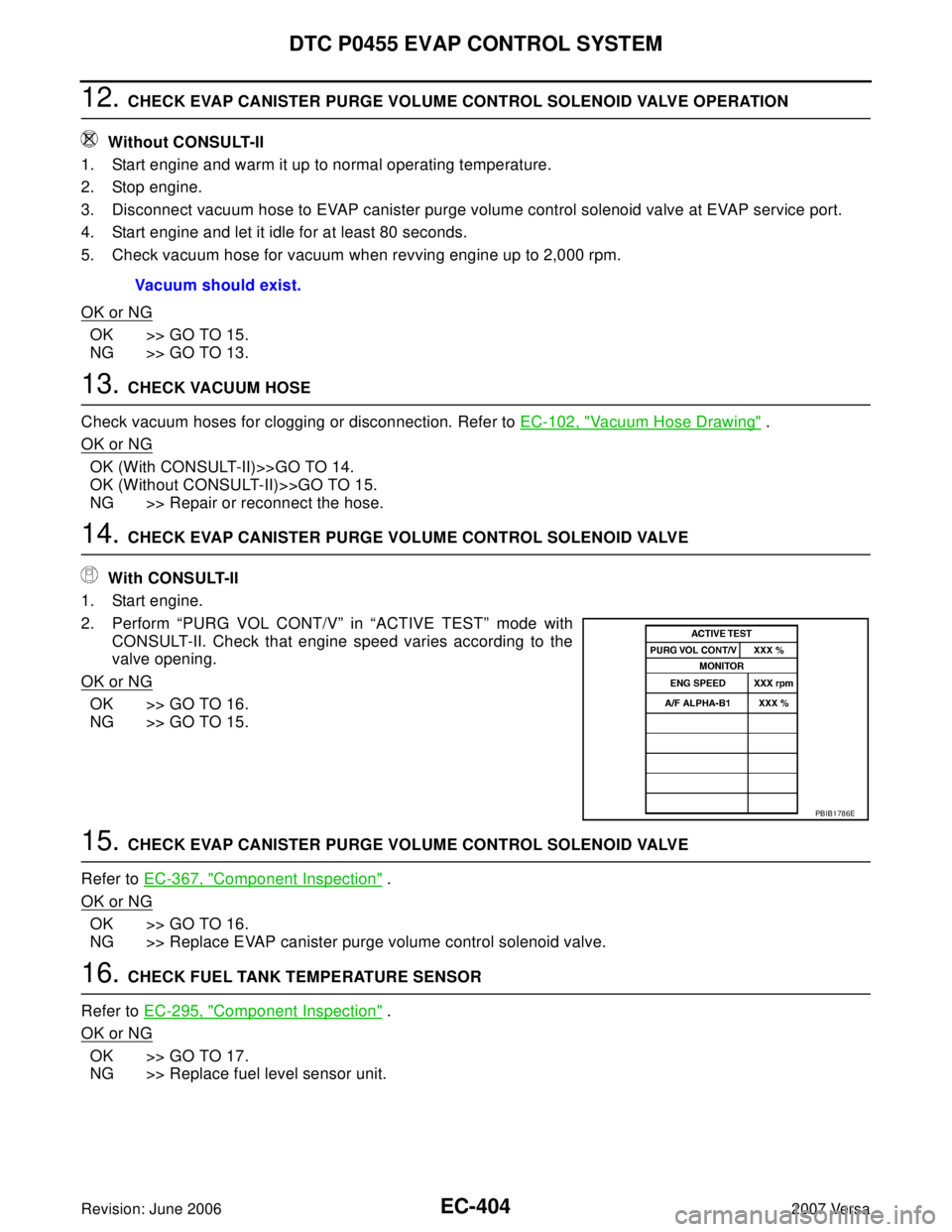
EC-404Revision: June 2006
DTC P0455 EVAP CONTROL SYSTEM
2007 Versa
12. CHECK EVAP CANISTER PURGE VOLUME CONTROL SOLENOID VALVE OPERATION
Without CONSULT-II
1. Start engine and warm it up to normal operating temperature.
2. Stop engine.
3. Disconnect vacuum hose to EVAP canister purge volume control solenoid valve at EVAP service port.
4. Start engine and let it idle for at least 80 seconds.
5. Check vacuum hose for vacuum when revving engine up to 2,000 rpm.
OK or NG
OK >> GO TO 15.
NG >> GO TO 13.
13. CHECK VACUUM HOSE
Check vacuum hoses for clogging or disconnection. Refer to EC-102, "
Vacuum Hose Drawing" .
OK or NG
OK (With CONSULT-II)>>GO TO 14.
OK (Without CONSULT-II)>>GO TO 15.
NG >> Repair or reconnect the hose.
14. CHECK EVAP CANISTER PURGE VOLUME CONTROL SOLENOID VALVE
With CONSULT-II
1. Start engine.
2. Perform “PURG VOL CONT/V” in “ACTIVE TEST” mode with
CONSULT-II. Check that engine speed varies according to the
valve opening.
OK or NG
OK >> GO TO 16.
NG >> GO TO 15.
15. CHECK EVAP CANISTER PURGE VOLUME CONTROL SOLENOID VALVE
Refer to EC-367, "
Component Inspection" .
OK or NG
OK >> GO TO 16.
NG >> Replace EVAP canister purge volume control solenoid valve.
16. CHECK FUEL TANK TEMPERATURE SENSOR
Refer to EC-295, "
Component Inspection" .
OK or NG
OK >> GO TO 17.
NG >> Replace fuel level sensor unit.Vacuum should exist.
PBIB1786E
Page 1574 of 2896
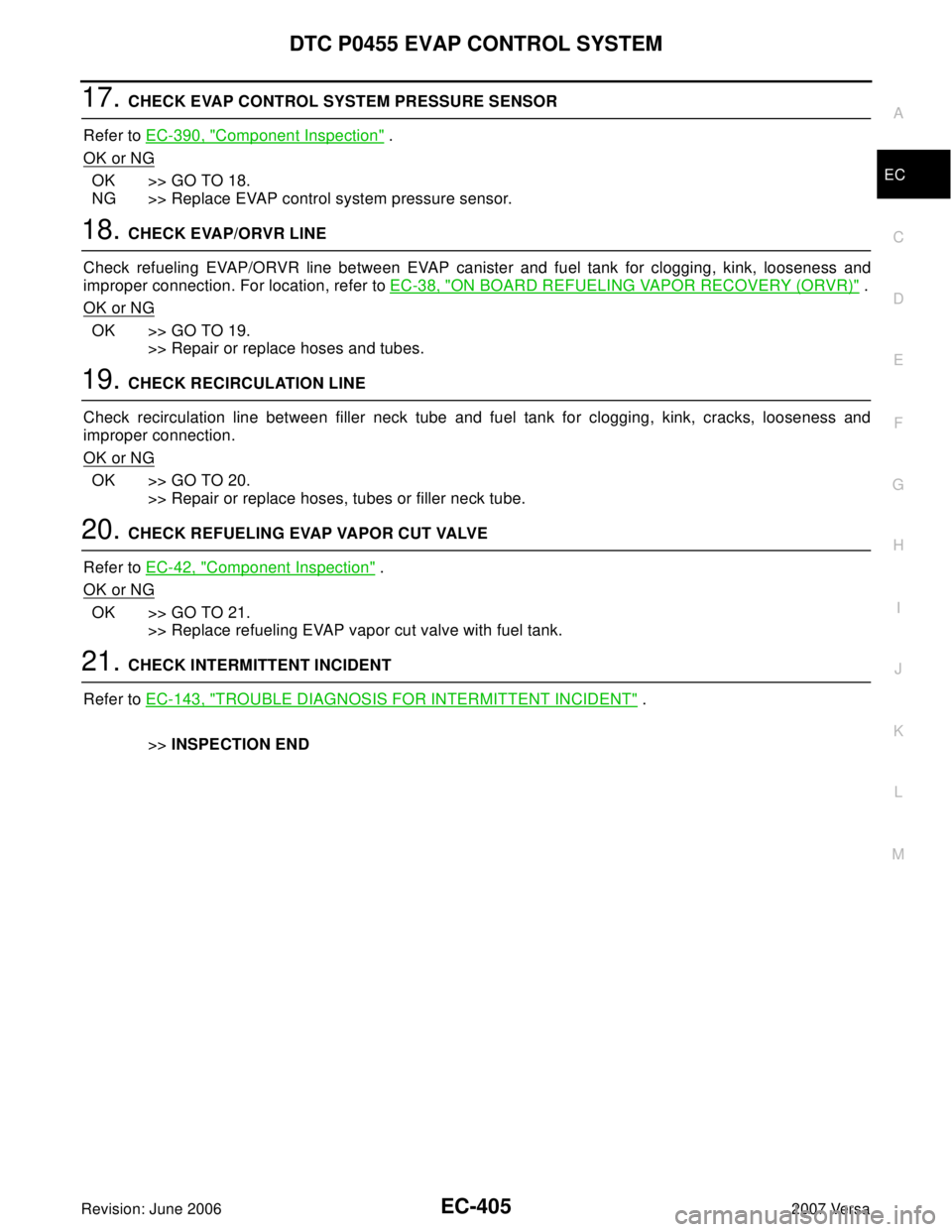
DTC P0455 EVAP CONTROL SYSTEM
EC-405
C
D
E
F
G
H
I
J
K
L
MA
EC
Revision: June 20062007 Versa
17. CHECK EVAP CONTROL SYSTEM PRESSURE SENSOR
Refer to EC-390, "
Component Inspection" .
OK or NG
OK >> GO TO 18.
NG >> Replace EVAP control system pressure sensor.
18. CHECK EVAP/ORVR LINE
Check refueling EVAP/ORVR line between EVAP canister and fuel tank for clogging, kink, looseness and
improper connection. For location, refer to EC-38, "
ON BOARD REFUELING VAPOR RECOVERY (ORVR)" .
OK or NG
OK >> GO TO 19.
>> Repair or replace hoses and tubes.
19. CHECK RECIRCULATION LINE
Check recirculation line between filler neck tube and fuel tank for clogging, kink, cracks, looseness and
improper connection.
OK or NG
OK >> GO TO 20.
>> Repair or replace hoses, tubes or filler neck tube.
20. CHECK REFUELING EVAP VAPOR CUT VALVE
Refer to EC-42, "
Component Inspection" .
OK or NG
OK >> GO TO 21.
>> Replace refueling EVAP vapor cut valve with fuel tank.
21. CHECK INTERMITTENT INCIDENT
Refer to EC-143, "
TROUBLE DIAGNOSIS FOR INTERMITTENT INCIDENT" .
>>INSPECTION END
Page 1575 of 2896
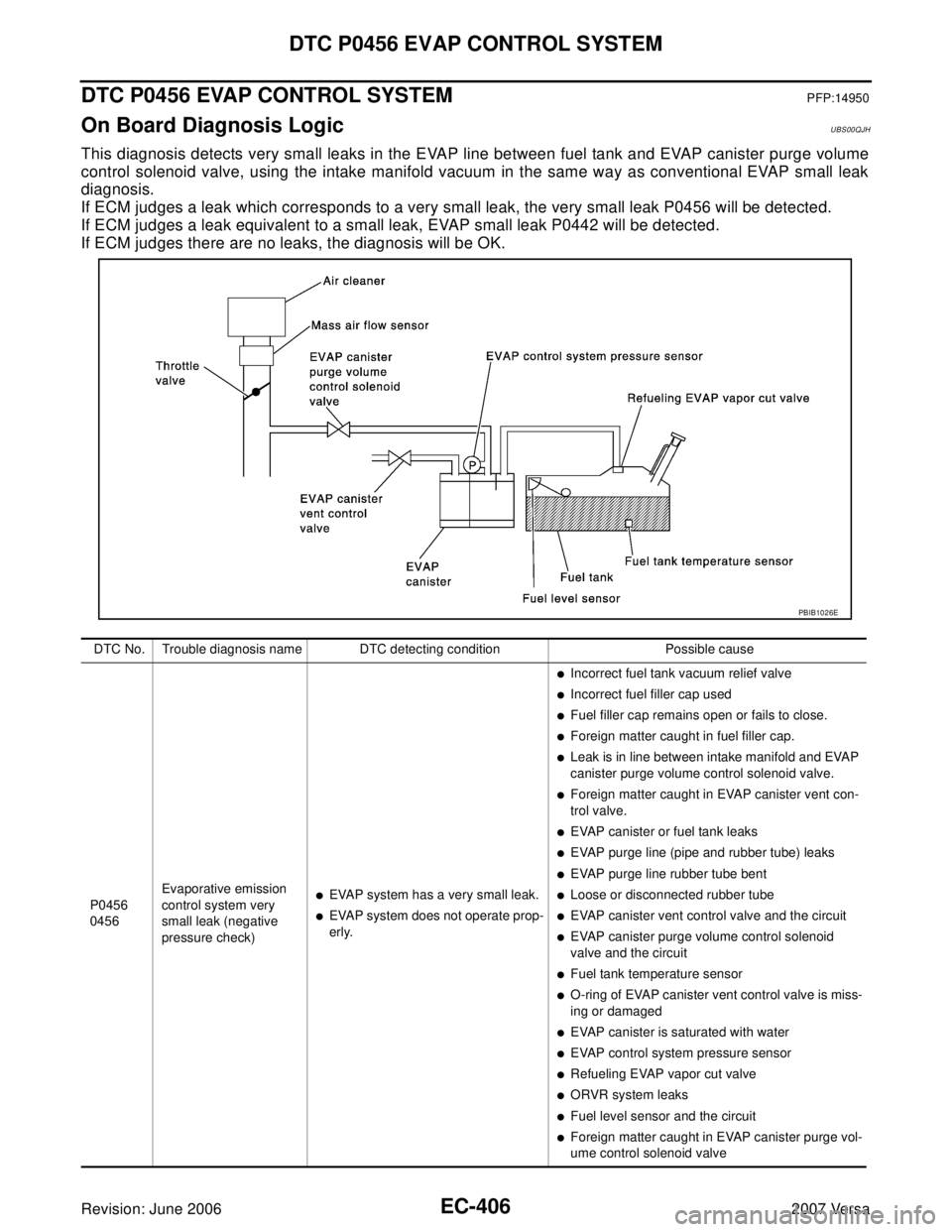
EC-406Revision: June 2006
DTC P0456 EVAP CONTROL SYSTEM
2007 Versa
DTC P0456 EVAP CONTROL SYSTEMPFP:14950
On Board Diagnosis LogicUBS00QJH
This diagnosis detects very small leaks in the EVAP line between fuel tank and EVAP canister purge volume
control solenoid valve, using the intake manifold vacuum in the same way as conventional EVAP small leak
diagnosis.
If ECM judges a leak which corresponds to a very small leak, the very small leak P0456 will be detected.
If ECM judges a leak equivalent to a small leak, EVAP small leak P0442 will be detected.
If ECM judges there are no leaks, the diagnosis will be OK.
DTC No. Trouble diagnosis name DTC detecting condition Possible cause
P0456
0456Evaporative emission
control system very
small leak (negative
pressure check)
�EVAP system has a very small leak.
�EVAP system does not operate prop-
erly.
�Incorrect fuel tank vacuum relief valve
�Incorrect fuel filler cap used
�Fuel filler cap remains open or fails to close.
�Foreign matter caught in fuel filler cap.
�Leak is in line between intake manifold and EVAP
canister purge volume control solenoid valve.
�Foreign matter caught in EVAP canister vent con-
trol valve.
�EVAP canister or fuel tank leaks
�EVAP purge line (pipe and rubber tube) leaks
�EVAP purge line rubber tube bent
�Loose or disconnected rubber tube
�EVAP canister vent control valve and the circuit
�EVAP canister purge volume control solenoid
valve and the circuit
�Fuel tank temperature sensor
�O-ring of EVAP canister vent control valve is miss-
ing or damaged
�EVAP canister is saturated with water
�EVAP control system pressure sensor
�Refueling EVAP vapor cut valve
�ORVR system leaks
�Fuel level sensor and the circuit
�Foreign matter caught in EVAP canister purge vol-
ume control solenoid valve
PBIB1026E
Page 1580 of 2896
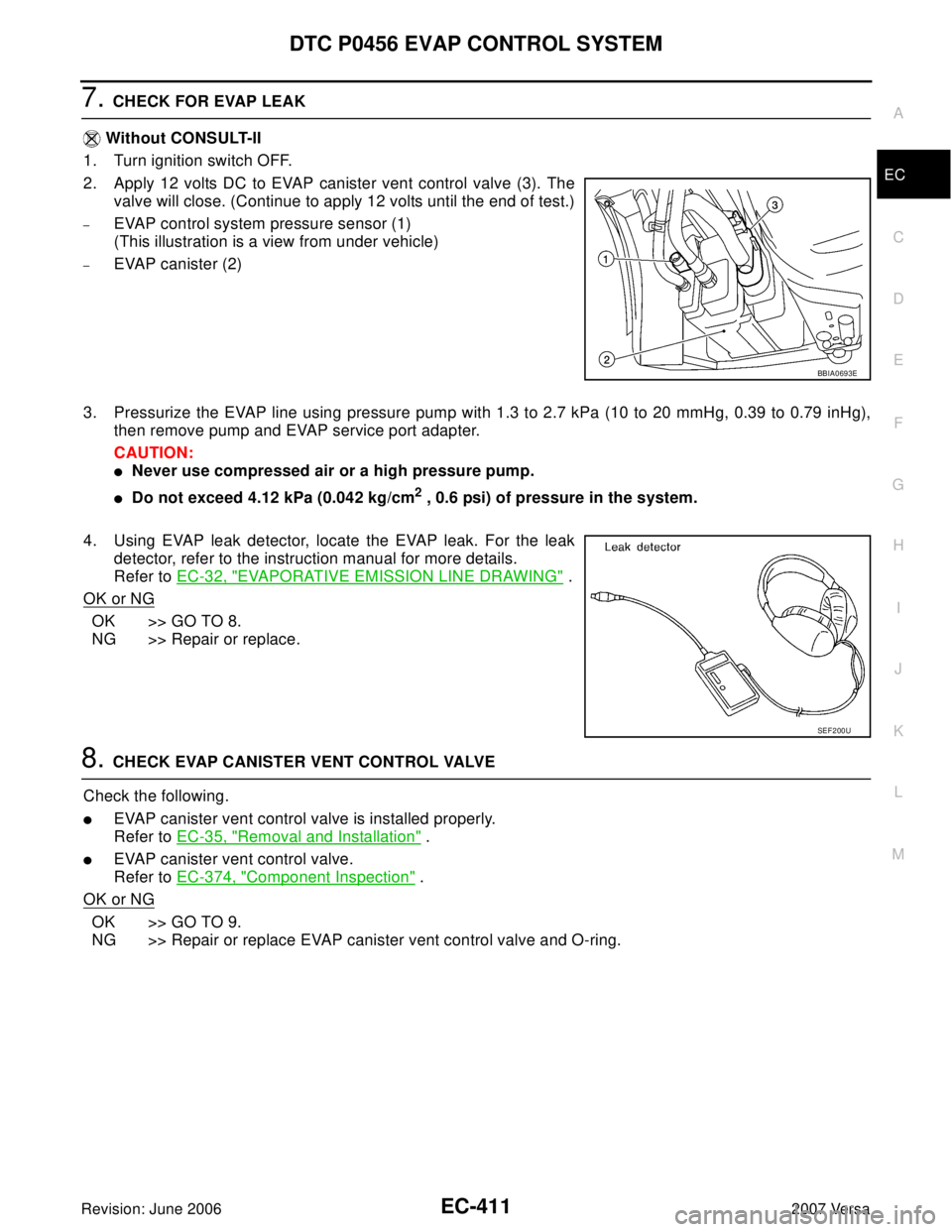
DTC P0456 EVAP CONTROL SYSTEM
EC-411
C
D
E
F
G
H
I
J
K
L
MA
EC
Revision: June 20062007 Versa
7. CHECK FOR EVAP LEAK
Without CONSULT-II
1. Turn ignition switch OFF.
2. Apply 12 volts DC to EVAP canister vent control valve (3). The
valve will close. (Continue to apply 12 volts until the end of test.)
–EVAP control system pressure sensor (1)
(This illustration is a view from under vehicle)
–EVAP canister (2)
3. Pressurize the EVAP line using pressure pump with 1.3 to 2.7 kPa (10 to 20 mmHg, 0.39 to 0.79 inHg),
then remove pump and EVAP service port adapter.
CAUTION:
�Never use compressed air or a high pressure pump.
�Do not exceed 4.12 kPa (0.042 kg/cm2 , 0.6 psi) of pressure in the system.
4. Using EVAP leak detector, locate the EVAP leak. For the leak
detector, refer to the instruction manual for more details.
Refer to EC-32, "
EVAPORATIVE EMISSION LINE DRAWING" .
OK or NG
OK >> GO TO 8.
NG >> Repair or replace.
8. CHECK EVAP CANISTER VENT CONTROL VALVE
Check the following.
�EVAP canister vent control valve is installed properly.
Refer to EC-35, "
Removal and Installation" .
�EVAP canister vent control valve.
Refer to EC-374, "
Component Inspection" .
OK or NG
OK >> GO TO 9.
NG >> Repair or replace EVAP canister vent control valve and O-ring.
BBIA0693E
SEF 2 00 U
Page 1581 of 2896
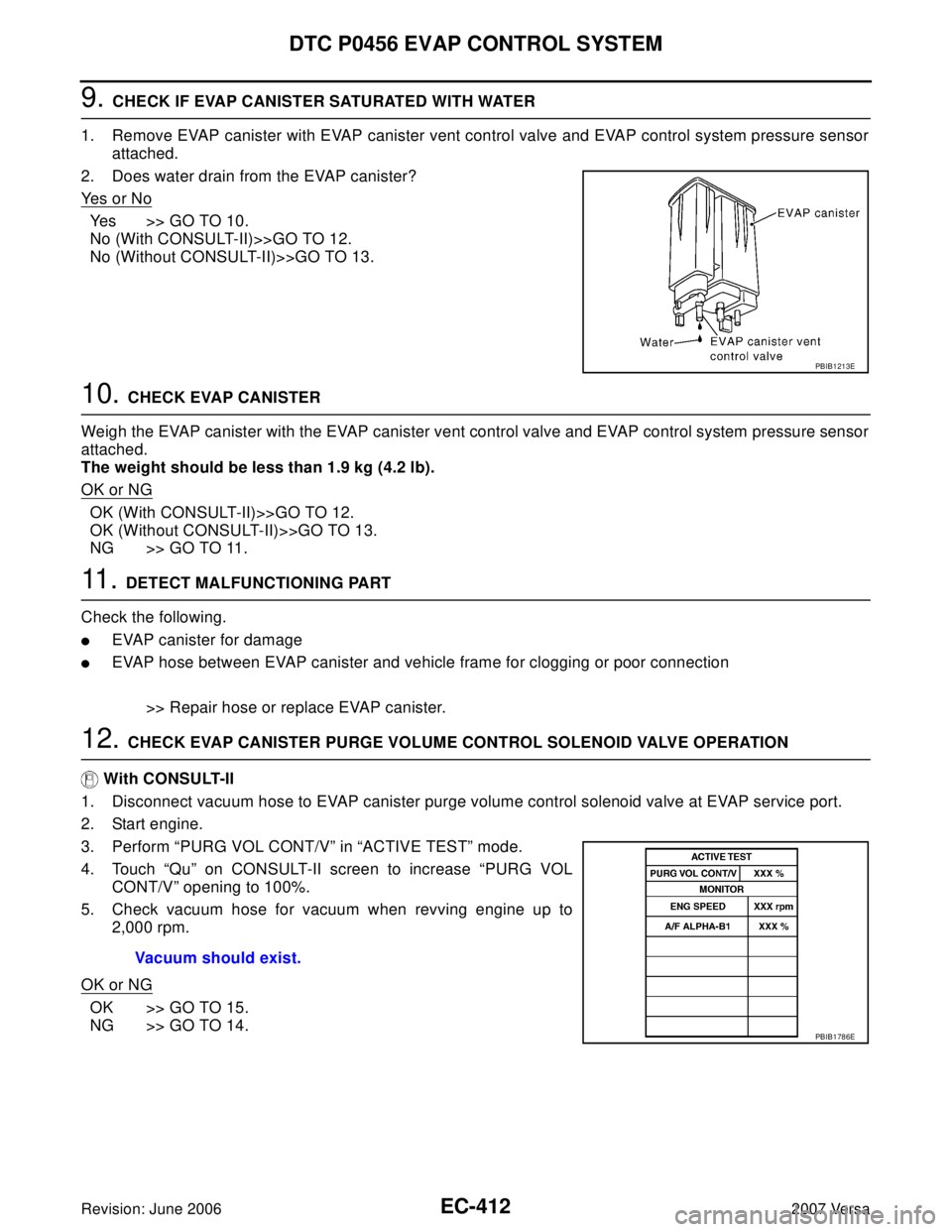
EC-412Revision: June 2006
DTC P0456 EVAP CONTROL SYSTEM
2007 Versa
9. CHECK IF EVAP CANISTER SATURATED WITH WATER
1. Remove EVAP canister with EVAP canister vent control valve and EVAP control system pressure sensor
attached.
2. Does water drain from the EVAP canister?
Ye s o r N o
Yes >> GO TO 10.
No (With CONSULT-II)>>GO TO 12.
No (Without CONSULT-II)>>GO TO 13.
10. CHECK EVAP CANISTER
Weigh the EVAP canister with the EVAP canister vent control valve and EVAP control system pressure sensor
attached.
The weight should be less than 1.9 kg (4.2 lb).
OK or NG
OK (With CONSULT-II)>>GO TO 12.
OK (Without CONSULT-II)>>GO TO 13.
NG >> GO TO 11.
11 . DETECT MALFUNCTIONING PART
Check the following.
�EVAP canister for damage
�EVAP hose between EVAP canister and vehicle frame for clogging or poor connection
>> Repair hose or replace EVAP canister.
12. CHECK EVAP CANISTER PURGE VOLUME CONTROL SOLENOID VALVE OPERATION
With CONSULT-II
1. Disconnect vacuum hose to EVAP canister purge volume control solenoid valve at EVAP service port.
2. Start engine.
3. Perform “PURG VOL CONT/V” in “ACTIVE TEST” mode.
4. Touch “Qu” on CONSULT-II screen to increase “PURG VOL
CONT/V” opening to 100%.
5. Check vacuum hose for vacuum when revving engine up to
2,000 rpm.
OK or NG
OK >> GO TO 15.
NG >> GO TO 14.
PBIB1213E
Vacuum should exist.
PBIB1786E
Page 1582 of 2896
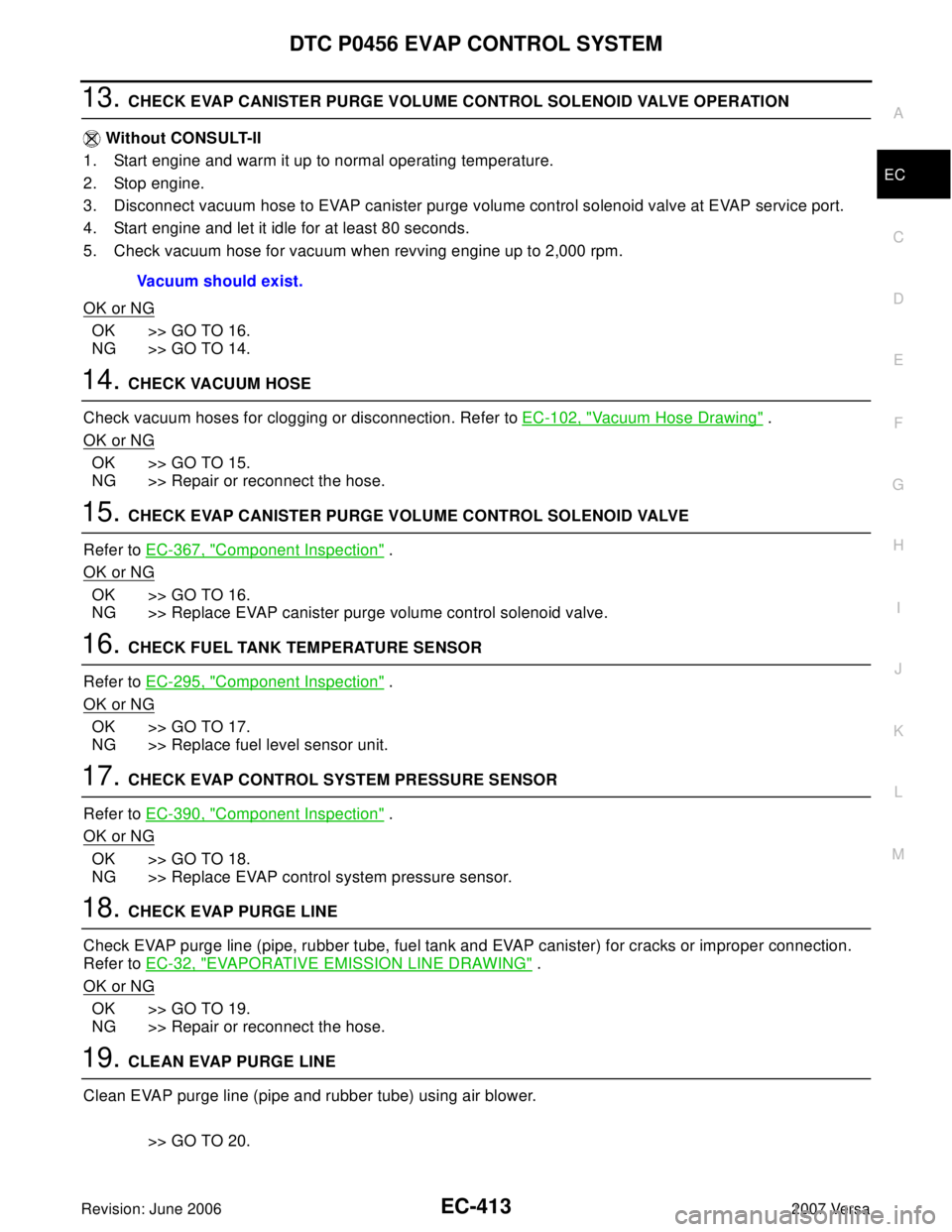
DTC P0456 EVAP CONTROL SYSTEM
EC-413
C
D
E
F
G
H
I
J
K
L
MA
EC
Revision: June 20062007 Versa
13. CHECK EVAP CANISTER PURGE VOLUME CONTROL SOLENOID VALVE OPERATION
Without CONSULT-II
1. Start engine and warm it up to normal operating temperature.
2. Stop engine.
3. Disconnect vacuum hose to EVAP canister purge volume control solenoid valve at EVAP service port.
4. Start engine and let it idle for at least 80 seconds.
5. Check vacuum hose for vacuum when revving engine up to 2,000 rpm.
OK or NG
OK >> GO TO 16.
NG >> GO TO 14.
14. CHECK VACUUM HOSE
Check vacuum hoses for clogging or disconnection. Refer to EC-102, "
Vacuum Hose Drawing" .
OK or NG
OK >> GO TO 15.
NG >> Repair or reconnect the hose.
15. CHECK EVAP CANISTER PURGE VOLUME CONTROL SOLENOID VALVE
Refer to EC-367, "
Component Inspection" .
OK or NG
OK >> GO TO 16.
NG >> Replace EVAP canister purge volume control solenoid valve.
16. CHECK FUEL TANK TEMPERATURE SENSOR
Refer to EC-295, "
Component Inspection" .
OK or NG
OK >> GO TO 17.
NG >> Replace fuel level sensor unit.
17. CHECK EVAP CONTROL SYSTEM PRESSURE SENSOR
Refer to EC-390, "
Component Inspection" .
OK or NG
OK >> GO TO 18.
NG >> Replace EVAP control system pressure sensor.
18. CHECK EVAP PURGE LINE
Check EVAP purge line (pipe, rubber tube, fuel tank and EVAP canister) for cracks or improper connection.
Refer to EC-32, "
EVAPORATIVE EMISSION LINE DRAWING" .
OK or NG
OK >> GO TO 19.
NG >> Repair or reconnect the hose.
19. CLEAN EVAP PURGE LINE
Clean EVAP purge line (pipe and rubber tube) using air blower.
>> GO TO 20. Vacuum should exist.
Page 1583 of 2896

EC-414Revision: June 2006
DTC P0456 EVAP CONTROL SYSTEM
2007 Versa
20. CHECK EVAP/ORVR LINE
Check EVAP/ORVR line between EVAP canister and fuel tank for clogging, kink, looseness and improper con-
nection. For location, refer to EC-38, "
ON BOARD REFUELING VAPOR RECOVERY (ORVR)" .
OK or NG
OK >> GO TO 21.
NG >> Repair or replace hoses and tubes.
21. CHECK RECIRCULATION LINE
Check recirculation line between filler neck tube and fuel tank for clogging, kink, cracks, looseness and
improper connection.
OK or NG
OK >> GO TO 22.
NG >> Repair or replace hose, tube or filler neck tube.
22. CHECK REFUELING EVAP VAPOR CUT VALVE
Refer to EC-42, "
Component Inspection" .
OK or NG
OK >> GO TO 23.
NG >> Replace refueling EVAP vapor cut valve with fuel tank.
23. CHECK FUEL LEVEL SENSOR
Refer to FL-5, "
FUEL LEVEL SENSOR UNIT, FUEL FILTER AND FUEL PUMP ASSEMBLY" .
OK or NG
OK >> GO TO 24.
NG >> Replace fuel level sensor unit.
24. CHECK INTERMITTENT INCIDENT
Refer to EC-143, "
TROUBLE DIAGNOSIS FOR INTERMITTENT INCIDENT" .
>>INSPECTION END